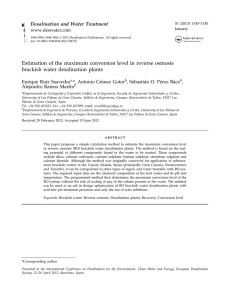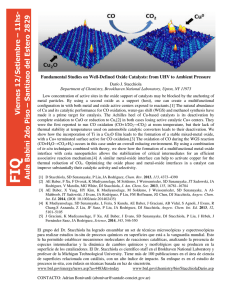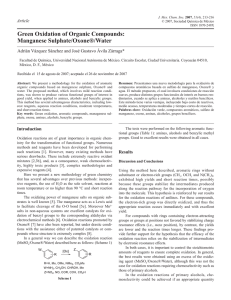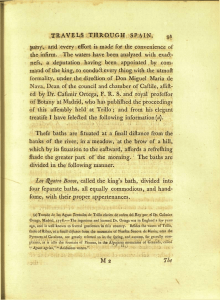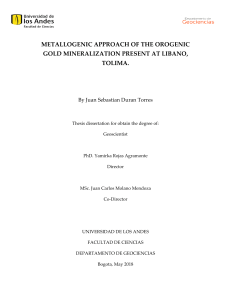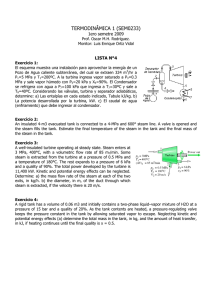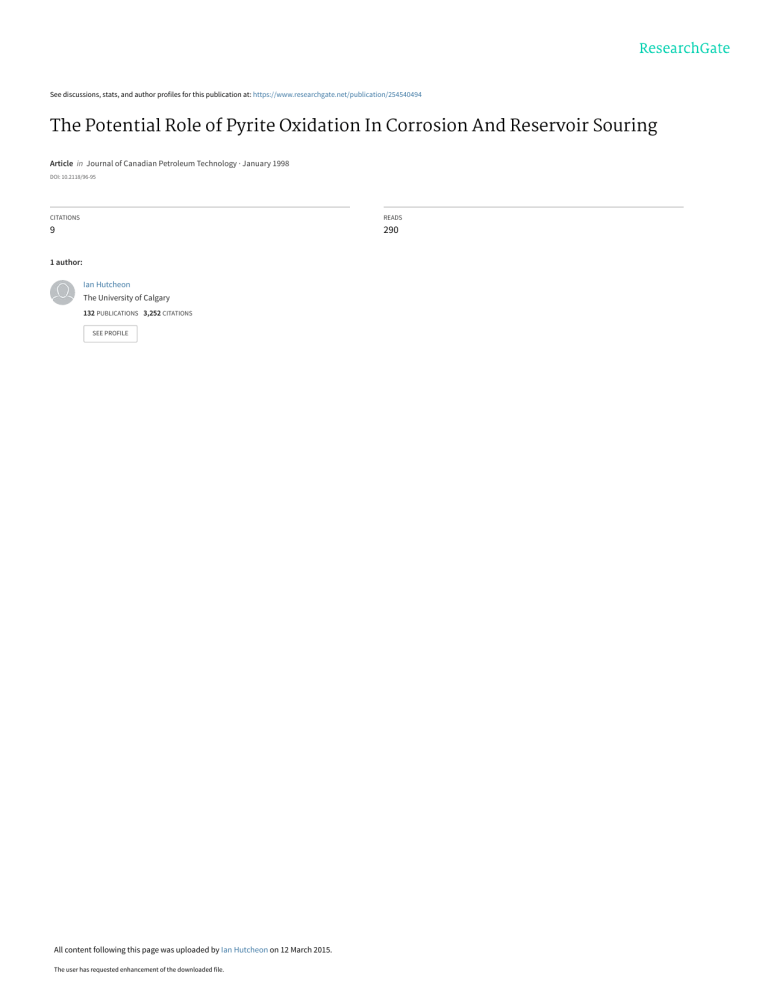
See discussions, stats, and author profiles for this publication at: https://www.researchgate.net/publication/254540494 The Potential Role of Pyrite Oxidation In Corrosion And Reservoir Souring Article in Journal of Canadian Petroleum Technology · January 1998 DOI: 10.2118/96-95 CITATIONS READS 9 290 1 author: Ian Hutcheon The University of Calgary 132 PUBLICATIONS 3,252 CITATIONS SEE PROFILE All content following this page was uploaded by Ian Hutcheon on 12 March 2015. The user has requested enhancement of the downloaded file. The Potential Role of Pyrite Oxidation in Corrosion and Reservoir Souring I. HUTCHEON University of Calgary Abstract Pyrite (FeS2) is a common and ubiquitous constituent of reservoir rocks and forms geologically under extremely reducing conditions. Pyrite is easily oxidized by exposure to moderately oxidizing conditions, including de-oxygenated injection or process water. When pyrite is oxidized in water, the resulting products include sulphuric acid (H2SO4) and sulphate ion (SO42-). In the near well bore, the resulting waters are far from equilibrium with Portland type well cements. A small amount of pyrite oxidation can result in total removal of well cement and the replacement of the cement by structurally less stable products, such as calcium sulphate. In addition, the sulphuric acid may result in corrosion of well tubing or above ground facilities. Casing leaks, particularly in injection wells, may lead to failures of casing due to cement collapse, tubing corrosion, or both. In the reservoir, during water flooding or steam injection, pyrite oxidation may release sulphate ion (SO42-) which can promote the activity of sulphate reducing bacteria, resulting in “souring” and the production of the acids gases H2S and CO2, where no production of acid gas was noted before injection. The results of pyrite oxidation are examined using reaction path modeling, in which the effects on reservoir fluids and rocks of these complex chemical reactions, including corrosion and scaling, can be determined. Introduction Pyrite (FeS2) is an ubiquitous constituent of carbonate and clastic reservoir rocks. Pyrite is particularly abundant in shales, and may be an unrecognized cause of well bore or casing failures in shaly intervals. Pyrite is only stable at very low oxidation states, partly depending on the pH and temperature, and consequently is very susceptible to oxidation during injection of fluids of relatively high oxidation state, such as steam or water from water floods. The objective of this paper is to show the possible consequences of pyrite oxidation for well bore cement stability and the effect on the composition of formation fluids. Chemical models are used to determine whether the changes in fluid chemistry can have significant effects on the stability of well cement (portlandite) and common reservoir minerals, such as calcite. One of the consequences of oxidation of a sulphide mineral is the release of sulphate to the aqueous fluid. In the typical hydrocarbon reservoir environment this provides a sulphate source for anaerobes that reduce sulphate to sulphide, resulting in the creation of sour gas in water flooded reservoirs that previously were not subject to sour production. Limited data from steam and water flood operations suggest that pyrite oxidation may occur, leading January 1998, Volume 37, No. 1 to the possibility that such pilots may become subject to sour production as production proceeds. Pyrite Oxidation and Cement Dissolution The oxidation of pyrite does not require a source of “free” oxygen, but can utilize the oxygen in water. Observation of Reaction (1) below shows that, in addition to the release of sulphate, oxidation of pyrite will release hydrogen ions, producing acidic conditions. Effectively, the product of pyrite oxidation and dissolution is sulphuric acid. FeS2 + 8 H2O ⇔ Fe2+ + 2SO2-4 + 16 H+ + 14 e- .........................(1) The main constituent of well cements, used to bond casing to the formation, is portlandite [Ca(OH)2]. Well cements are stable at pH values in the range of 9 or 10, or alkaline conditions relative to most formation waters. It is logical that the oxidation of pyrite, since it will cause acidic conditions to form, will potentially cause portlandite to become unstable, resulting in dissolution of the well cement. FeS2 + 6 H2O + Ca(OH)2 ⇔ Fe2+ + Ca2+ + 2SO2-4 + 14 H+ + 14 e- ......................................(2) Reaction (2) shows that there is no requirement for molecular oxygen, the process can occur by the transfer of electrons. A minor leak of injected fluid, whether water or steam, through the casing joins, could easily provide the pathway for electron transfer between the injected fluid and fluid in the near well bore region, allowing the reaction to proceed. Data in the literature suggest that rates of pyrite oxidation at 25°C are rapid enough to be observed in a few years and they are faster at higher temperatures. Before discussing chemical modelling of the effect of steam or water leakage, and the effects of resulting oxidation of sulphide, we will present evidence that there is the potential for pyrite oxidation in steam injection pilots and in conventional reservoirs at higher temperatures. Evidence for Pyrite Oxidation Between 25° and 100°C Various chemical substances may be involved in oxidationreduction reactions, represented as redox couples. Among the multitude of possible redox couples observed in oil field waters, are sulphate-sulphide and organic acids or organic acid-bicarbon27 FIGURE 2: The variation in sulphate concentration as a function of temperature for the Husky Tucker Lake steam pilot. FIGURE 1: The variation in log fO2 as a function of temperature for three redox reactions observed in oil field waters. ate redox couples(1) may be present. In naturally occurring oil field waters recognizing which of a number of redox couples is at equilibrium is difficult if not impossible. The fugacity of O2 (fO2) is used commonly as a measure of oxidation state and can be shown to be equivalent to Eh or electron activity.(2) The use of (fO2) does not imply that molecular oxygen is present, it is simply a measure of the level of oxidation. Figure 1 shows at one atmosphere and as a function of temperature, the change of the log of oxygen fugacity (fO2), which is a measure of redox conditions, for three possible redox couples that may reflect the oxidation state of oil field waters. Representative analyses of oil field waters(3-5) and the equilibrium constants for the redox couples sulphate-sulphide (3), ethanoic-propanoic acid (4), and ethanoic acid-bicarbonate (5), the oxidation state as fO2 was calculated as a function of temperature at one bar total pressure. There is considerable controversy as to which, if any, of these reactions is at redox equilibrium in oil field waters. However, they represent the probable range of oxidation conditions. orders of magnitude lower than surface conditions. Reaction (1) is recast as Reaction (6) to use oxygen to show the “oxidation” reaction of pyrite. It is clear from Reaction (6) that an increase in oxygen fugacity must result in an increase in sulphate concentration. Figure 1 shows that regardless of which redox system may represent the oxidation state of oil field waters, the fugacity of oxygen increases systematically as temperature increases. FeS2 + H2O + F _7 O2 ⇔ Fe2+ + 2SO2-4 + 2 H+ 2 ......................(6) Figure 2 shows the values of dissolved sulphate measured at the Husky Tucker Lake steam pilot (6). Because the oxidation state, as expressed by oxygen fugacity, increases with temperature, the systematic increase of sulphate as temperature increases is consistent with the oxidation of pyrite. Pyrite is observed to be ubiquitous in the reservoir interval at the Tucker Lake pilot(7). The two major sources of sulphur in most clastic reservoirs, where sulphate minerals are absent, are pyrite and sulphur in hydrocarbons. It is not possible with the available data to determine with certainty that pyrite oxidation is the source of this correlation, however the sulphur isotopic composition (8) suggests that sulphur in oil is likely not to be the source of the sulphate observed at Tucker Lake. 2 H+ + 2SO2-4 ⇔ H2S + 2 O2 .............................................................(3) 3 CH3COOH ⇔ 2 CH3CH2COOH + O2 ........................................(4) CH3COO- + 2 O2 ⇔ 2HCOs- + H+ ....................................................(5) For comparison with the fO2 values reported on Figure 1, standard dissolved oxygen meters for measuring the concentration of oxygen in waters, can only detect values of 10-6, or greater, in oxygen fugacity. It is important to note that the possible values of fO2 are in the range of 10-70 to 10-80 at 25°C, and increase with increasing temperature to a range between 10-50 to 10 -60 at 100°C. These values are far lower than are consistent with any dissolved molecular oxygen being present in water and represent extremely reducing conditions that are much more reducing than ground water or surface water used in water flooding, or steam process waters treated to lower the dissolved oxygen content. The redox couples shown in Figure 1 display a range of possible fO 2 values at a particular temperature, demonstrating that they are not in redox equilibrium. It is common that redox couples in waters will not apparently be in equilibrium. Regardless of the actual value of log fO2 in oil field waters, it is certainly many 28 Modelling Pyrite Oxidation and Cement Dissolution Having established that pyrite oxidation is a potential source of acidic conditions, the next step is to examine the chemical consequences of Reaction (2) in a well bore with portlandite cement bonding the casing to the formation. Upper Cretaceous Colorado group shales are shallowly buried over much of Alberta and commonly are uphole of perforated intervals in wells used for both conventional and thermal recovery. This unit is widespread in Alberta, is very typical of many Cretaceous shales in Alberta and contains pyrite rich horizons, such as the Second White Specks(9). Shales of the Colorado Group were selected as the basis for a conceptual model to examine the potential for well bore failures during steam injection. Typical well bore characteristics for a steam injection well were used to establish a model for calculations. We have assumed an outside diameter of the casing of 177.8 mm and an average diameter of the well bore of 251 mm. For a metre length of well bore and casing, the total volume between the casing and the well bore is 0.2632 m3, which we assume to be completely occupied by portlandite, giving the absolute maximum volume of cement between the well bore and casing. The molar volume portlandite is 33.056 cc/mol, thus per metre of well bore there are 7.45 moles The Journal of Canadian Petroleum Technology FIGURE 3: Conceptual model of the well bore-cement-shale system used to establish starting conditions for chemical modeling. of portlandite which establishes a starting mass for model calculations. A conceptual view of the well bore for purposes of the model is shown in Figure 3. The calculations were completed using EQ3/6(10-11), a chemical modelling code that completes reaction path calculations. This computer model establishes a system at equilibrium, in this case consisting of the portlandite cement, the mineralogy of the shale surrounding the well bore, and the associated shale pore water. The model then allows the stepwise addition or removal of a chemical component and keeps track of the net changes in the chemical composition of the water and the minerals associated with the shale and the cement. At each step the model searches for minerals that are either under saturated or over saturated and adds or subtracts the appropriate amount of each mineral until equilibrium is re-established. The program then updates the water composition. In this way, the changes in the water chemistry and the amounts of minerals added by precipitation and removed by dissolution can be accounted for as a substance is “titrated” into the system. In the model calculations given here, oxygen is titrated into the system to allow an increase from an oxidation state representative of the well bore environment with shale and portlandite present, to an oxidation state consistent with the slow leakage of steam, that is relatively oxidizing, through the joints in the casing. The rates of steam leakage were determined from inert gas leakage measurements on typical pipe used for steam injection well casing. A minimum leakage rate was used so as to give a conservative estimate of the effect of oxidation. The first step in the simulation was to obtain a water composition representative of rocks in the Colorado Group. The water used was from the Basal Fish Scales Formation of the Colorado Group and had the following composition. Na Ca Mg pH = = = = 1629 mg/L 42 mg/L 4 mg/L 9.6 Cl = HCO3 = SO4 = CO3 = 1400 mg/L 1100 mg/L 226 mg/L 333 mg/L The next step is to establish equilibrium between this water, the shale and portlandite cement. The shale, in addition to silicate minerals and pyrite, is assumed to contain calcite(9). Once this equilibration step was completed the final pH was 5.3, reflecting the very “acidic” nature of pyrite. The calculation was then allowed to proceed, simulating the oxidation of pyrite and tracking the dissolution or precipitation of portlandite and the minerals present in the shale. Once the initial conditions were established, oxygen was added in very small steps to simulate a change to relatively oxidizing conditions into the cement-shale-water system. An average of 3.0 weight per cent pyrite is assumed to be present in the shale at the well bore face and only the pyrite in the top one (1.0) mm of the shale is considered to be accessible to the fluid. It is important to note that no leakage of steam is required to cause January 1998, Volume 37, No. 1 FIGURE 4: The results of chemical modeling of the oxidation of pyrite in the presence of portlandite well cement and typical shale minerals. The vertical band at approximately 0.0075 m3 of pyrite consumed represent the volume of shale contacted by a minimum size leak equivalent to seepage through pipe joints. oxidation of pyrite. Simple electron transfer between the injected steam, through the electrically conductive pipe to the near well bore environment, will result in increased oxidation state. In the simulation we have assumed that the minimum seepage rate of inert gas is representative of steam leakage and is the driver for the oxidation of pyrite. The computer program then tracks the volumes of portlandite and pyrite consumed, compared to the products produced as these two minerals dissolve. Modelling Results The results of the modelling are portrayed graphically in Figure 4 which represents the volume of portlandite consumed as pyrite is oxidized and shows the minerals that would be expected to form. From inspection of Reaction (2) it is clear that as pyrite is oxidized, portlandite is dissolved. Figure 4 shows the change in volume of various minerals as pyrite is consumed by oxidation, the volume of pyrite consumed is shown on the horizontal axis. The numbers on the figure are referred to the following text that describes the sequence of dissolution and precipitation of minerals. 1. At the start of the reaction, pyrite, portlandite and calcite are assumed to be present. The products of the reaction are iron, calcium and sulphate ions in solution, in addition to continuously increasing acidity. The total volume (approximately 0.025 m3) of portlandite, based on the volumes given from the casing and well bore diameters, and calculated per metre of well, is shown on the left hand axis. 2. As the reaction starts, portlandite is consumed by the acid produced by pyrite oxidation. Anhydrite (CaSO4) volume starts to increase, because the sulphate produced by pyrite oxidation is reacting with the calcium released from portlandite dissolution. Magnetite (Fe3O4) is produced because the iron released from pyrite rapidly over saturates the system with magnetite which has a low solubility. 3. All the portlandite is consumed and the acid produced by pyrite oxidation starts to attack calcite (CaCO3) present in the shale, releasing carbonate ions. The carbonate ions react with iron from pyrite dissolution to produce siderite (FeCO3). 4. Calcite starts to dissolve and the amount of anhydrite keeps increasing because calcite is now supplying the needed calcium. There is still abundant pyrite, even though the calculation only started with 3% in the rock. 5. Hematite (Fe2O3) appears because the oxidation state is constantly increasing and at this point the oxidation state crosses the magnetite-hematite stability boundary. It is likely that the dissolution of portlandite during pyrite oxi29 FIGURE 5: Variation of Na and Cl in Rapdan fluids. The injection waters are mixtures of source water and formation water. dation will compromise the integrity of the cement bond between the well bore and the formation. In addition, the portlandite and pyrite are providing the constituents required to form anhydrite or gypsum (both calcium sulphate minerals) and the heavy dashed line in Figure 4 shows the total volume of all minerals is greater than the volume of portlandite (shown by the broad gray horizontal band). The oxidation of pyrite in the presence of portlandite well cements is potentially a serious problem in terms of well failure. The removal of support during portlandite dissolution, combined with the increased total volume of products of the complex reactions that occur, could possibly cause shearing of the pipe. Leakage of low salinity injection fluids, such as condensed steam, could cause swelling of expandable clays in shales. Units in the Colorado Group, in addition to containing intervals rich in pyrite, are smectite rich(9). Observation of Reaction (1) shows the potential for the corrosion of the well casing itself. The corrosive attack of steel during pyrite oxidation could also contribute to well casing failure. Overall the leakage of injection fluids could, by a multiplicity of mechanisms, be an initiator for well bore instability problems. Pyrite Oxidation as a Source of Acid Gas The progressive souring of reservoirs is sometimes observed, but well documented occurrences are rarely reported. There are natural occurrences of bacterial souring of Mannville reservoirs in southern Alberta in the vicinity of Long Coulee, Badger and Taber fields(4). In this setting the source of sulphate is saline water from Mississippian rocks that lie underneath the Mannville and the driving force is the incursion of surface waters by hydrodynamic drive from the Sweetgrass Arch. In water flooded reservoirs, the source of sulphate is not always so obvious. Souring is caused by the reduction of sulphate to sulphide and generally requires, at low temperatures, the presence of bacteria and an organic food source. The bacteria “breathe” the oxygen from the sulphate, reducing it to sulphide, and oxidize reduced carbon (hydrocarbons) to carbon dioxide. Therefore reduction of sulphate results in the production of H2S and CO2, both of which are acid gases. The Rapdan field in Saskatchewan is a polymer enhanced water flood and some limited water data have been published(1213). Figure 5 uses this data to show the range of water compositions, from very fresh source water and relatively fresh injection water, with more saline production waters. Produced waters are necessarily a mixture of injected and formation waters. Over the period from 1983 to 1986 the Rapdan production waters appear to have become more saline, although this is very difficult to determine at the field scale since it is not clear that the same wells were sampled and the movement of injection water through a field is 30 FIGURE 6: Variation in sulphate and bicarbonate content of fluids from Rapdan. The drop in sulphate may represent sulphate reduction. homogeneous. Figure 6 shows the sulphate and bicarbonate concentrations of the same waters as a function of chloride. The less saline 1983 production sample has significantly lower sulphate and bicarbonate than the 1986 sample. The reduced sulphate concentration could reflect sulphate reduction, although this should be accompanied by elevated bicarbonate concentration, which is not observed. Sour production has been observed in this field, so it is possible that sulphate reduction does account for the drop in sulphate concentration. The reduction in bicarbonate might be due to precipitation of carbonate minerals such as calcite, which is observed to accompany sulphate reduction in some Mannville Reservoirs(4). Sulphate levels in formation and injection waters are often found to be low and the identification of a sulphate source for bacterial sulphate reduction is not obvious. Pyrite is a ubiquitous mineral in carbonates and clastics and the oxidation of pyrite, such as in Reaction (1) is a possible source of sulphate as relatively oxidizing water is injected during water flooding or steam flooding. Although the temperatures in the early cycles of steam flooding are far too extreme to allow bacteria to survive, at later stages and later cycles sulphate that has been “banked” on the fringes of cyclic injection wells could start to be reduced by bacteria and sour production may well increase during the later stages of a thermal recovery project. Conclusions Pyrite is a common mineral in many reservoir rocks and is extremely common in shales. The oxidation of pyrite provides both acid and a potential supply of sulphate that could be utilized by sulphate reducing bacteria. In shales, leakage of well bores in pyrite rich intervals may result in attack of portlandite cement and well tubing, resulting in failure. In reservoirs during water flooding and steam injection, the release of sulphate from pyrite oxidation may result in souring as bacteria utilize the sulphate. The sulphate reduction reaction will cause progressive increase in production of the acid gases H2S and CO2. The mechanisms of these processes could be quantified by detailed sampling and examination of the chemical and isotopic compositions of produced waters and gases. Acknowledgements Acknowledgement is made to the donors of the Petroleum Research Fund, administered by the American Chemical Society, for partial support of this research. The Journal of Canadian Petroleum Technology REFERENCES 1. HELGESON, H.C., KNOX, A.M., OWENS, C.E. and S H O C K , E.L., 1993. Petroleum Oil Field Brines and Authigenic Mineral Assemblages: Are they in Metastable Equilibrium in Hydrocarbon Reservoirs?; Geochimica et Cosmochimica Acta, v. 57, pp. 32953340. 2. ANDERSON, G., 1995. Aqueous Geochemistry; C a m b r i d g e University Press, p. 217. 3. CONNOLLY, C.A., WALTER, L.M., BAADSGAARD, H, a n d LONGSTAFFE, F.J., Origin and Evolution of Formation Waters; Alberta Basin., I, Chemistry: Applied Geochemistry, v. 5, pp. 375396, 1990a,. 4. CODY, J., 1993, Geochemistry of Formation Fluids in the Mannville Group (Lwr. Cret.), Southern Alberta: Sources, Controls and Waterrock Interaction of Carbon Dioxide Rich Fluids; Unpublished MSc thesis, Department of Geology and Geophysics, University of Calgary, p. 129. 5. KHARAKA, Y.K., LAW, L.M., CAROTHERS, W.W. and GOERLITZ, D.F., Role of Organic Species Dissolved in Formation Waters from Sedimentary Basins in Mineral Diagenesis: In: D.L. Gautier (ed.), Roles of Organic Matter in Sediment Diagenesis; Society of Economic Paleontologists and Mineralogists, Special Publication 38, pp. 111-122, 1986. 6. HUTCHEON I. and ABERCROMBIE, H.J., Fluid-rock Interactions in Thermal Recovery of Bitumen, Tucker Lake Pilot, Cold Lake, Alberta, In: Prediction of Reservoir Quality through Chemical M o d e l l i n g ; Eds. Indu D. Meshri and P.J. Ortoleva, American Association of Petroleum Geologists Memoir 49, pp. 161-170, 1990. 7. HUTCHEON, I., ABERCROMBIE, H.J., PUTNAM, P., KROUSE, H.R. and GARDNER, R., Diagenesis and Sedimentology of the Clearwater Formation at Tucker Lake; Bulletin of Canadian Petroleum Geology, v. 37, pp. 83-97, 1989. 8. HUTCHEON, I., SHEVALIER, M., and KROUSE, H.R., Chemical and Isotopic Examination of Produced Waters from the BP Wolf Lake in situ Combustion Pilot; Applied Geochemistry v. 10, pp. 6583, 1995.. 9. CARITAT, P. DE, BLOCH, J., HUTCHEON, I., and LONGSTAFFE, F.J., Compositional Trends of a Cretaceous Foreland Basin Shale (Belle Fourche Formation, Western Canada Sedimentary Basin): Diagenetic and depositional controls; Clay Minerals, v. 29, pp. 503-526, 1994. 10. WOLERY, T.J., EQ3NR, A Computer Program for Geochemical Aqueous Speciation-solubility Calculations; Theoretical manual, user’s guide, and related documentation (version 7.0). Lawrence Livermore National Laboratory, UCRL-MA-110662 PTIII. p. 246, 1992. 11. WOLERY, T.J., and DAVELAR, S.A., EQ6, A Computer Program for Reaction Path Modelling of Aqueous Systems; Theoretical man ual, User’s guide, and related documentation (Version 7.0). UCRLMA-110662 PTIV. p. 338, 1992. 12. CAMPBELL, T.A. and MCKECHNIE, R.B., Progress Report on the Rapdan Polymer Flood; CIMM paper 12, Regina, October 6 – 8, 1987, 1987. 13. CAMPBELL, T.A. and BACHMAN, R.C., Polymer Augmented Waterflood in the Rapdan Upper Shaunavon Unit; CIMM paper 18, Regina, September 15 – 17, 1985. Author’s Biography Ian Hutcheon is currently a professor and head of the department of geology and geophysics at the University of Calgary. Before joining the U. of C. he worked for mining companies and the Geological Survey of Canada. He was worked in thermal recovery and on the origin of carbon dioxide and sour gas in deep reservoirs in Alberta. He received a B.Sc. in 1969 from the University of British Columbia and an M.Sc. (1972) and Ph.D. (1977) from Carlton University in Ottawa. Dr. Hutcheon is a member of APEGGA, the Canadian Society of Petroleum Geologists, the Society of Petroleum Engineers and numerous other professional societies. P r o v e n a n c e —Original Petroleum Society manuscript, T h e Potential Role of Pyrite Oxidation in Corrosion and Reservoir Souring (96-95), first presented at the 47th Annual Technical Meeting, June 10-12, 1996, in Calgary, Alberta. Abstract submitted for review February 2, 1996; editorial comments sent to the author(s) March 18, 1997; revised manuscript received May 7, 1997; paper approved for pre-press May 9, 1997; final approval June 25, 1997.M January 1998, Volume 37, No. 1 View publication stats 31
